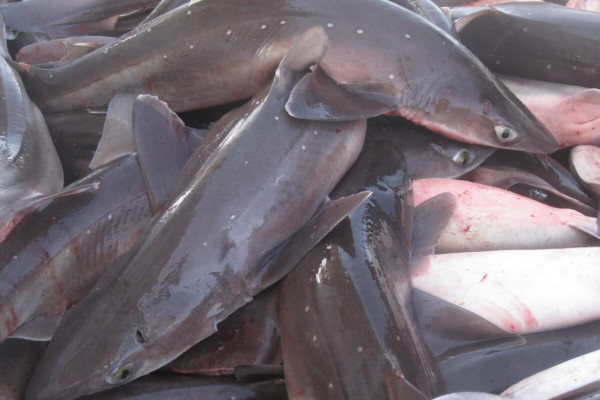
Dogfish has had an interesting 100 years. File photo.
By Seth Rolbein
The year 1916 went down as one of the greatest in the fishing history of Massachusetts.
Here’s Dr. David L. Belding’s description, author of the 51st annual report of the Massachusetts Commissioners on Fisheries and Game (meaning the first report was written in 1865, as the Civil War ended):
“Prosperity ruled the waves for the salt-water fishermen of Massachusetts in 1916. Even the most grizzled ‘old timer’ who is wont to lounge about the wharves and ‘gloom’ each bright, present-day fishing success story with ‘That reminds me,’ and ‘Nuthin like in ’78 when I,’ etc., was forced to admit, ‘I never see nothing like it, no, sir.’
“For amount of fish landed in comparison with tonnage engaged, as well as for the enormous stocks and shares made by vessels, crews and fish-curing and shipping concerns generally 1916 will long be known as ‘the record year,’ unless old ocean should decide in this, or some other year to come, to just dump all at once her whole Klondike wealth of finny, swimming treasure on the decks of the fishing fleet.”
Dr. Belding, a biologist and physician as well as a fine writer, backed up his wonderful prose with a great statistical analysis of New England’s landings. For mackerel alone, he reported that more than 130,000 barrels (mainly fresh, some salted) was landed that year. As a barrel would weigh around 200 pounds, that’s 26 million pounds of mackerel, with boats often grossing as much as $30,000 to $50,000 per trip; economists say that a 1916 dollar’s buying power is equivalent to more than $2000 today, which would make these voyages almost impossibly profitable.
Belding is remembered to this day by an award bearing his name, dispensed annually by the state’s fisheries commission to someone who has contributed much to fishery efforts. He died in 1972, but his seminal work on everything from shellfish to marine pathology, eelgrass, even early documentation of the need to reduce oil pollution, remains among the most thoughtful science produced along our shores.
That’s partly why another short chapter in his 1916 report resonates 103 years later, reminding us that as things change they also can stay the same.
Amidst all the prosperity, Belding turned his attention to one fish with a poor reputation due mainly, he’d heard tell, to its unfortunate name. His ulterior motive was to highlight a campaign to change the moniker.
Sound familiar? Sure enough it was the dogfish, or as Belding named his chapter, “THE POOR ‘DOG’”:
“It is little wonder that the name of this poor denizen of the deep has had but little chance to grace the bill of fare of a three-penny lunch, much more the menu card of one of our select hostelries.
“Officials of the United States Bureau of Fisheries would have it that the well-known popular antipathy is only ‘name deep.’ According to statements made by them the title of the ‘critter’ is its great handicap, but is that quite consistent? Is it not a fact that perfectly good membrane-covered horse meat, heated and wedged between two halves of a roll, is by popular acclaim given the nom de plume ‘hot dog’?
“We have not noticed the difference. However, that is our only quarrel with the honorable projectors of the dogfish-consuming campaign. None of the other points they set forth are open to dispute. That the dogfish, beg pardon, grayfish (the suggested inoffensive way of saying dogfish in the future), is fully as tasty and nutritious as the majority of our ‘finny foods,’ and better in many respects than some, is an established fact. If the application of the name ‘grayfish’ will help to overcome the foolish prejudice now so widespread, let it by grayfish …
“The fish were put on the market canned, and the Massachusetts Fish and Game Commissioners can testify to its toothsomeness, both plain and in salad form. This coming season it is expected that many more crafts will engage in fishing for grayfish, and, as it can be marketed at a low price to the consumer, it is expected to soon take its place as a staple article of diet.”
By today’s sensibility, calling a fish “gray” doesn’t seem to add to its appeal much. Maybe that was the case then too, because “grayfish” didn’t take hold, no matter how “toothsome” the state’s commissioners found it. Then again, a century later “hot dogs” are more popular than ever, even if they no longer are made with horse meat.
Too bad Dr. Belding isn’t still around to offer his perspective on that.
(With thanks to Kristen Uiterwyck, director of the UMass Boston Urban Harbors Institute, for calling our attention to this historical nugget)
